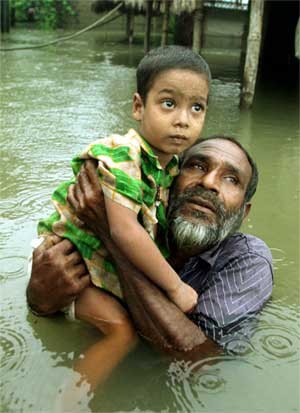 Whilst the Green’s Jamboree is on in Copenhagen, it is worthwhile to examine one country in particular. Bangladesh. The warmists like to trot Bangladesh out as one of the countries threatened by global warming and rising sea levels. Whilst it is true that Bangladesh has huge problems, these cannot be laid at the door the warmists want to leave them at.
Whilst the Green’s Jamboree is on in Copenhagen, it is worthwhile to examine one country in particular. Bangladesh. The warmists like to trot Bangladesh out as one of the countries threatened by global warming and rising sea levels. Whilst it is true that Bangladesh has huge problems, these cannot be laid at the door the warmists want to leave them at.
Bangladesh suffers from three principal problems:
– Lack of land.
– Lack of money.
– Excess of population.
Essentially, Bangladesh is a low lying country of 55,598 square miles (England is 50, 352 sq miles) but with a population in excess of 150 million. Half the country lies at an elevation between thirty feet and sea level. In 1901 the population stood below 30 million. Now the pressure of population causes the people to live on the extremes, virtually at the water’s edge. Is it not surprising therefore that every time a hurricane strikes there is such turmoil ?
The physiography of Bangladesh is characterized by two distinctive features: a broad deltaic plain subject to frequent flooding, and a small hilly region crossed by swiftly flowing rivers. On the south is a highly irregular deltaic coastline, fissured by many rivers and streams flowing into the Bay of Bengal. Roughly 80 percent of the landmass is made up of fertile alluvial lowland called the Bangladesh Plain. The plain is part of the larger Plain of Bengal, which is sometimes called the Lower Gangetic Plain. Although altitudes up to 350 feet above sea level occur in the northern part of the plain, most elevations are less than 35 feet above sea level; elevations decrease in the coastal south, where the terrain is generally at sea level. With such low elevations and numerous rivers, water–and concomitant flooding–is a predominant physical feature. About 3,860 square miles of the total area of Bangladesh is covered with water, and larger areas are routinely flooded during the monsoon season. The alluvial soils in the Bangladesh Plain are generally fertile and are enriched with heavy silt deposits carried downstream during the rainy season.
What Bangladesh needs is an extensive system of sea walls and dykes along the lines of Holland. This of course is fantastically expensive and Bangladesh does not have the money to pay for it. However her people are enthusiastic workers and want to overcome their difficulties. Given that the politicians of the rich first world are keen to waste money generating electricity through ludicrous wind turbines and not the cheaper coal fired power stations would not the money be better spent purchasing the coastal land from the Bangladesh government, then finance the constructing the necessary sea walls and then rent the land back to them ?
Speaking the Truth unto the Nation
